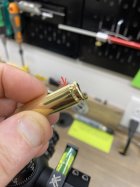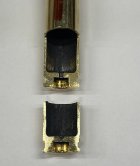While inspecting three different batches of brass, I ran a paper clip in a few cases and noticed a dip right before the case head. I went through each batch and picked one case from each that showed the most obvious sign that I believe could be case head separation. From what I have seen, I would suspect that the separation point would be higher up on the case wall and not as low as shown in the pictures. The exterior of the case shows a faint line, or should I say, a slight raised shoulder that goes all the way around the diameter of the case. From my understanding, the raised shoulder is caused by the resizing die. I could be wrong. Below are the details on my reloading process for case prep and history on the brass in question.
1. De-prime
2. Tumble to remove any and all debris from brass.
3. Anneal. Induction annealer at 4.5 seconds. Confirmed with 750 deg. Tempilaq.
4. Run brass through ring die if needed to avoid clickers. I do this every other reload. More on that below.
5. Resize with Wilson bushing die setting shoulder back .001-.002 thou using Redding comp shell holder set.
6. Trim to 2.005”, debur and chamfer case mouth.
Case 1 - Red batch. Lapua 308 win, Fired 9x, 178 gr ELDM, 44.7 gr Varget, 2770 fps range.
Case 2 - Blue batch. Lapua 308 win, Fired 9x, 178 gr ELDM, 44.7 gr Varget, 2770 fps range.
Case 3 - Orange batch. Lapua 308 win, Fired 3x, 178 gr ELDM, 44.7 gr Varget, 2770 fps range.
Powder charge is in the high node and heavy bolt lift / extractor marks are noticed at 45.5 gr. I might be a little hot.
All cases were fired in the same rifle, same barrel, chamber, etc with the exception of the orange batch. The first two firings were done in the same rifle as batch red and blue. Third firing on the orange batch was full length resized to min specs, and fired in a different rifle with fresh barrel and chamber. New rifle barrel length is shorter so at 43.5 velocity is in the 2640 fps range.
Circling back to step 4 on the sizing process. I found that the I.D. on my ring die is .465 which may be over working the base too much. I’m wondering if this is causing the so called separation above the case head. My ring die is a Lee 45ACP body die with a carbide sizing ring. It was an experimental thing discussed with a few that I thought I would try. I have since reached out to a fellow member here on this forum and inquired on his ring die which measures out at .468. My chambers were cut using a 308 Palma reamer and my smith likes them just a tad in the tight side. I don’t think my sizing die is knocking the base down enough, so I have to size the base every other reload.
Sorry for the long drawn out post. Just wanted make sure I got all the details out there.
Could this be case head separation?
Thanks
JMD82






1. De-prime
2. Tumble to remove any and all debris from brass.
3. Anneal. Induction annealer at 4.5 seconds. Confirmed with 750 deg. Tempilaq.
4. Run brass through ring die if needed to avoid clickers. I do this every other reload. More on that below.
5. Resize with Wilson bushing die setting shoulder back .001-.002 thou using Redding comp shell holder set.
6. Trim to 2.005”, debur and chamfer case mouth.
Case 1 - Red batch. Lapua 308 win, Fired 9x, 178 gr ELDM, 44.7 gr Varget, 2770 fps range.
Case 2 - Blue batch. Lapua 308 win, Fired 9x, 178 gr ELDM, 44.7 gr Varget, 2770 fps range.
Case 3 - Orange batch. Lapua 308 win, Fired 3x, 178 gr ELDM, 44.7 gr Varget, 2770 fps range.
Powder charge is in the high node and heavy bolt lift / extractor marks are noticed at 45.5 gr. I might be a little hot.
All cases were fired in the same rifle, same barrel, chamber, etc with the exception of the orange batch. The first two firings were done in the same rifle as batch red and blue. Third firing on the orange batch was full length resized to min specs, and fired in a different rifle with fresh barrel and chamber. New rifle barrel length is shorter so at 43.5 velocity is in the 2640 fps range.
Circling back to step 4 on the sizing process. I found that the I.D. on my ring die is .465 which may be over working the base too much. I’m wondering if this is causing the so called separation above the case head. My ring die is a Lee 45ACP body die with a carbide sizing ring. It was an experimental thing discussed with a few that I thought I would try. I have since reached out to a fellow member here on this forum and inquired on his ring die which measures out at .468. My chambers were cut using a 308 Palma reamer and my smith likes them just a tad in the tight side. I don’t think my sizing die is knocking the base down enough, so I have to size the base every other reload.
Sorry for the long drawn out post. Just wanted make sure I got all the details out there.
Could this be case head separation?
Thanks
JMD82



















